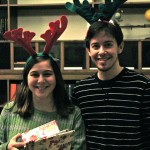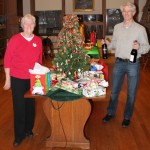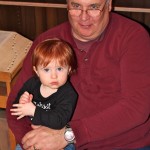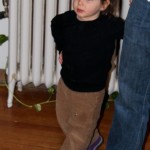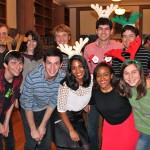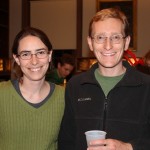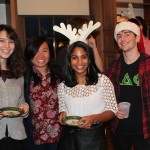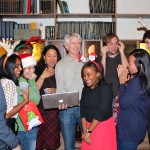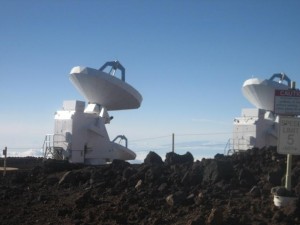
Where engineers build their telescopes, astronomers will inevitably come. One of the great perks of having a career path associated with the night sky is the opportunity to visit places where the stars I study shine the brightest. Thanks to Wesleyan University’s newest Assistant Professor of Astronomy, Meredith Hughes, I (Eric Edelman ’13) was able to assist as a student observer at the Submillimeter Array (SMA) on the big island of Hawaii for spring break. Mahalo, Meredith!
The SMA is a telescope array composed of eight individual antennas that specializes in submillimeter, or radio, wavelengths. It is situated near 13,000 feet above sea level, close to the summit of Mauna Kea, one of Hawaii’s inactive volcanoes. This daunting altitude helps the SMA to avoid many atmospheric issues that particularly stymie ground based submillimeter observations. Fortunately, the observing station has an oxygenated control room, so I was able to remain coherent enough during my stay to absorb and document my nights as half guest observer and half gawking, consistently over-impressed tourist.
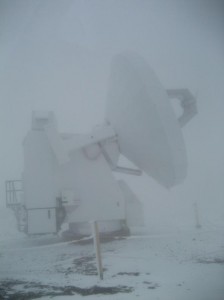 My five days on the summit gave me a quick glimpse into the many and varied challenges face by ground-based observers. In particular, the weather during my trip was extremely changeable. On my first night at that dark, isolated summit, the starry night sky was clear and vivid enough to drown in. That night, the SMA engineers worked on installing new hardware and the observers set the antennas’ sights on an AGN (active galactic nucleus), which is an extremely luminous galactic nucleus, thought to be caused by large-scale, energetic accretion of matter into the galaxy’s supremely supermassive black hole. However, by my fifth and last observing night, wind and icy snow buffeted the summit, shaded by thick, unmoving clouds, and observing or testing anything was as far from possible as it ever could be. A big portion of an observer’s job is to keep one’s eyes trained on those weather sites in order to adapt accordingly to whatever challenges the fickle weather patterns end up throwing his or her way.
My five days on the summit gave me a quick glimpse into the many and varied challenges face by ground-based observers. In particular, the weather during my trip was extremely changeable. On my first night at that dark, isolated summit, the starry night sky was clear and vivid enough to drown in. That night, the SMA engineers worked on installing new hardware and the observers set the antennas’ sights on an AGN (active galactic nucleus), which is an extremely luminous galactic nucleus, thought to be caused by large-scale, energetic accretion of matter into the galaxy’s supremely supermassive black hole. However, by my fifth and last observing night, wind and icy snow buffeted the summit, shaded by thick, unmoving clouds, and observing or testing anything was as far from possible as it ever could be. A big portion of an observer’s job is to keep one’s eyes trained on those weather sites in order to adapt accordingly to whatever challenges the fickle weather patterns end up throwing his or her way.
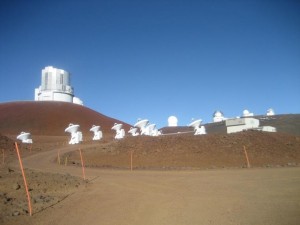 While the sudden snow storm was certainly exciting, I could not enjoy those nights quite as much as I could the clear ones, when actual observing occurred. On those nights, when everything was in working order, every so often I could not help but lean back in my chair in that chilly control room and try and digest the magnitude of this whole operation. Right in front of me, only about ten yards away, was an array of telescopes pointed at and collecting information on an object most likely millions of parsecs away from us. The scale and finesse of observational astronomy has never ceased to impress me, and seeing the SMA in action was a treat to be remembered.
While the sudden snow storm was certainly exciting, I could not enjoy those nights quite as much as I could the clear ones, when actual observing occurred. On those nights, when everything was in working order, every so often I could not help but lean back in my chair in that chilly control room and try and digest the magnitude of this whole operation. Right in front of me, only about ten yards away, was an array of telescopes pointed at and collecting information on an object most likely millions of parsecs away from us. The scale and finesse of observational astronomy has never ceased to impress me, and seeing the SMA in action was a treat to be remembered.
For any readers local to the Wesleyan campus, keep in mind that public observing is held at the campus observatory on clear Wednesday nights from 8:00-9:00pm. We cannot promise you AGNs, but I would still highly recommend a trip to Van Vleck to see the stars if you can make it!



